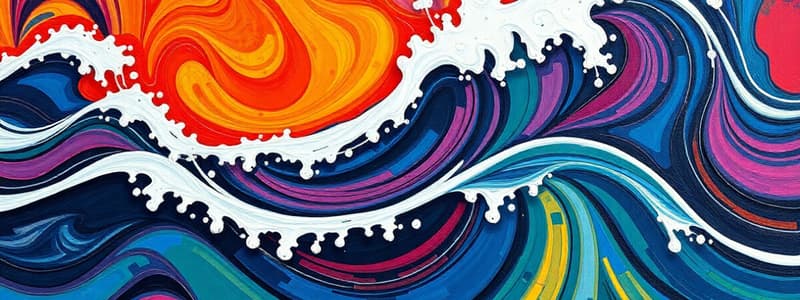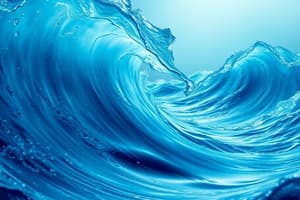Podcast
Questions and Answers
What best defines a wave?
What best defines a wave?
- A continuous flow of particles in a straight line.
- A one-time movement of matter without energy transfer.
- A repeating disturbance that transfers energy from place to place. (correct)
- A random occurrence of matter without any pattern.
Which of the following is an example of a mechanical wave?
Which of the following is an example of a mechanical wave?
- Radio wave
- Sound wave (correct)
- X-ray
- Light wave
What is a key characteristic of electromagnetic waves?
What is a key characteristic of electromagnetic waves?
- They do not need a medium to travel. (correct)
- They can only travel in a vacuum.
- They only travel through liquids.
- They require a medium to propagate.
Which of the following statements about waves and medium is correct?
Which of the following statements about waves and medium is correct?
How does a wave transfer energy in relation to its movement?
How does a wave transfer energy in relation to its movement?
Which of the following is classified as a mechanical wave?
Which of the following is classified as a mechanical wave?
What is the primary mechanism of energy transfer in longitudinal waves?
What is the primary mechanism of energy transfer in longitudinal waves?
In which type of wave do particles of the medium move perpendicular to the wave direction?
In which type of wave do particles of the medium move perpendicular to the wave direction?
What is the term for the low-pressure region in a longitudinal wave?
What is the term for the low-pressure region in a longitudinal wave?
Which of the following statements is NOT true about mechanical waves?
Which of the following statements is NOT true about mechanical waves?
Which type of wave is exemplified by a water wave?
Which type of wave is exemplified by a water wave?
What is the primary difference between transverse and longitudinal waves?
What is the primary difference between transverse and longitudinal waves?
Which of these best describes the movement of particles in a slinky during a longitudinal wave?
Which of these best describes the movement of particles in a slinky during a longitudinal wave?
What term describes the highest point in a transverse wave?
What term describes the highest point in a transverse wave?
Which of the following best defines a longitudinal wave?
Which of the following best defines a longitudinal wave?
Flashcards
Wave
Wave
A repeating disturbance that transfers energy from one place to another.
Medium
Medium
A substance or material through which a wave travels.
Mechanical Wave
Mechanical Wave
A wave that requires a medium to travel.
Electromagnetic Wave
Electromagnetic Wave
Signup and view all the flashcards
Wave Energy Transfer
Wave Energy Transfer
Signup and view all the flashcards
Transverse Wave
Transverse Wave
Signup and view all the flashcards
Longitudinal Wave
Longitudinal Wave
Signup and view all the flashcards
Compression
Compression
Signup and view all the flashcards
Rarefaction
Rarefaction
Signup and view all the flashcards
Crest
Crest
Signup and view all the flashcards
Trough
Trough
Signup and view all the flashcards
What are the two main types of waves?
What are the two main types of waves?
Signup and view all the flashcards
How are Mechanical Waves formed?
How are Mechanical Waves formed?
Signup and view all the flashcards
What does Mechanical Waves need to travel?
What does Mechanical Waves need to travel?
Signup and view all the flashcards
What is a wave?
What is a wave?
Signup and view all the flashcards
Study Notes
Module L: Waves and Their Applications
- This module studies waves and their applications.
- Unit 1 focuses on waves.
Day 1 - Lesson 1: Introduction to Waves
- Standards:
- MS-PS4-1: Use mathematical representations to describe a simple model for waves, including how amplitude relates to energy.
- MS-PS4-2: Develop a model to describe how waves are reflected, absorbed, or transmitted through materials.
- Objectives:
- Define wave.
- Give examples of mediums.
- Classify waves needing/not needing a medium.
- Compare/contrast mechanical and electromagnetic waves.
Vocabulary
- Wave
- Medium
- Mechanical wave
- Electromagnetic wave
Starter (Engage)
- Students should study a picture of a wave in the ocean and answer related questions.
What are Waves?
- A wave is a repeating disturbance that transfers energy from one place to another.
- Examples include light waves, sound waves, and water waves.
Wave Transfer Energy
- Waves transfer energy in the direction they travel.
- In a visual example, energy is transferring to the right as the wave moves to the right.
Medium
- A medium is a material through which a wave travels (e.g., air, liquid, solid).
- Based on whether a wave requires a medium, waves are classified into two types:
- Mechanical waves: Travel through a medium (e.g., sound).
- Electromagnetic waves: Do not need a medium to travel (e.g., light).
Check Your Understanding
- Categorize waves (water, sound, light, spring/slinky) as mechanical or electromagnetic. Provide the reasoning behind your choices.
Extension - Check Your Understanding
- A link to an online resource (https://wordwall.net/resource/35563615) is provided for additional material.
Day 2 - Lesson 1 (Continued): Types of Waves
- Standards:
- MS-PS4-1: Use mathematical representations to describe a simple model for waves, including how amplitude relates to energy.
- MS-PS4-2: Develop and use a model to describe that waves are reflected, absorbed, or transmitted through various materials.
- Objectives:
- List two types of waves.
- Define longitudinal and transverse waves.
- Label parts of longitudinal and transverse waves.
- Describe how mechanical waves form.
- Compare longitudinal and transverse waves.
Vocabulary
- Longitudinal wave
- Transverse wave
- Compression
- Rarefaction
- Crest
- Trough
Starter
- Students should draw a wave of any type they know.
Types of Mechanical Waves
- Transverse wave: Particles move perpendicular to the direction of the wave. (e.g., water waves, spring waves.)
- Longitudinal wave: Particles move parallel to the direction of the wave. (e.g., sound waves).
Checking Understanding
- Label diagrams of waves as either transverse or longitudinal.
2 Types of Mechanical Waves
- Transverse:
- Similarities: Both types transfer energy in their direction of travel and require a medium.
- Differences: Disturbances/vibrations move perpendicular to the wave's direction.
- Example: Water wave
- Longitudinal:
- Similarities: Both types transfer energy in their direction of travel and require a medium.
- Differences: Disturbances/vibrations move parallel to the wave's direction.
- Example: Sound wave
Parts of Transverse Waves
- Crest: Highest point of the wave.
- Trough: Lowest point of the wave.
- Amplitude: Distance from the rest position to the crest or trough.
- Wavelength: Distance from one crest to the next.
Parts of Longitudinal Waves
- Compression: Area where particles are close together.
- Rarefaction: Area where particles are spread apart.
- Amplitude: Maximum displacement from the rest position.
- Wavelength: Distance between two compressions or two rarefactions.
Think Pair Share - Check Your Understanding
- Draw parts of the two types of waves.
- Practice waves in ropes (link provided).
Independent Activity - Practice Labeling
- Label a diagram of waves using provided vocabulary.
Group Work (Explore) - Modeling Two Types of Waves
- Use a slinky to create different waves.
- Observe and record observations on how the slinky moves, the direction of movement, and the transfer of energy.
Check Your Understanding (Do This After the Activity)
- Compare and contrast longitudinal and transverse waves.
- Give an example for each type of wave.
- Identify the parts of longitudinal waves that correspond to crests and troughs of transverse waves.
- Draw diagrams of longitudinal and transverse waves.
Studying That Suits You
Use AI to generate personalized quizzes and flashcards to suit your learning preferences.




